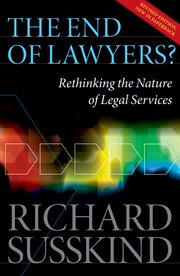303 pages
English language
Published Nov. 22, 2010 by Oxford University Press.

303 pages
English language
Published Nov. 22, 2010 by Oxford University Press.
This widely acclaimed legal bestseller has provoked a tidal wave of debate within the legal profession, being hailed as an inspiration by some and as heresy by others. Susskind lays down a challenge to all lawyers, and indeed all those in a professional service environment. He urges them to ask themselves, with their hands on their hearts, what elements of their current workload could be undertaken differently - more quickly, cheaply, efficiently, or to a higher quality - using alternative methods of working. The challenge for legal readers is to identify their distinctive skills and talents, the capabilities that they possess that cannot, crudely, be replaced by advanced systems or by less costly workers supported by technology or standard processes, or by lay people armed with online self-help tools.
In the extended new preface to this revised paperback edition, Richard Susskind updates his views on legal process outsourcing, courtroom …
This widely acclaimed legal bestseller has provoked a tidal wave of debate within the legal profession, being hailed as an inspiration by some and as heresy by others. Susskind lays down a challenge to all lawyers, and indeed all those in a professional service environment. He urges them to ask themselves, with their hands on their hearts, what elements of their current workload could be undertaken differently - more quickly, cheaply, efficiently, or to a higher quality - using alternative methods of working. The challenge for legal readers is to identify their distinctive skills and talents, the capabilities that they possess that cannot, crudely, be replaced by advanced systems or by less costly workers supported by technology or standard processes, or by lay people armed with online self-help tools.
In the extended new preface to this revised paperback edition, Richard Susskind updates his views on legal process outsourcing, courtroom technology, access to justice, e-learning for lawyers, and the impact of the recession on the practice of law. He analyses the four main pressures that lawyers now face (to charge less, to work differently, to embrace technology, and to deregulate), and reveals common fallacies associated with each. And, in an entirely new line of thinking, Susskind argues that law firms and in-house departments will have four business models from which to choose in the future, and he provides some new tools and techniques to help lawyers plan for their future.